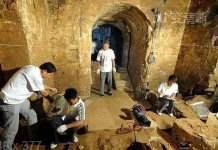A New Era of Archaeological Insights in Rizhao: Uncovering the Secrets of a Bronze Mirror with Remote Sensing Technology
 In an extraordinary archaeological endeavor in Rizhao, China, researchers have unveiled the mysteries of an ancient Bronze Mirror using advanced remote sensing technology. This discovery marks a significant breakthrough in our understanding of Bronze Age artifacts and the methods used to uncover them.
In an extraordinary archaeological endeavor in Rizhao, China, researchers have unveiled the mysteries of an ancient Bronze Mirror using advanced remote sensing technology. This discovery marks a significant breakthrough in our understanding of Bronze Age artifacts and the methods used to uncover them.
Located on the east coast of Shandong province, Rizhao has long been a site of historical interest. Recent excavations at a known Bronze Age settlement revealed the presence of an exceptionally well-preserved bronze mirror, dating back to approximately 3000 years ago. This discovery is not just a testament to the craftsmanship of ancient artisans but also a window into the daily lives of people from that era.
The team utilized high-resolution satellite imagery and ground-penetrating radar (GPR) to map the underground structure accurately. Dr. Li Wei, head of the excavation team, emphasized the importance of this approach: "Using remote sensing technology not only minimizes physical interference with the archaeological site but also provides us with precise data that enhances our findings."
The bronze mirror itself is adorned with intricate designs that suggest religious or ceremonial significance. According to Dr. Zhang, a historian at the China University of Mining and Technology (CUMT), these patterns reflect the cultural beliefs and rituals practiced by the local population during the Bronze Age. He notes, "These mirrors were more than just decorative objects; they were integral to daily life and held deep symbolic meaning."
Further analysis of the mirror will involve a combination of non-invasive techniques such as X-ray fluorescence (XRF) and digital imaging. Researchers aim to understand the composition of the mirror and the techniques employed in its creation. This comprehensive study promises to shed light on the technological advancements of the time and the societal structures of ancient communities.
This discovery, along with recent archaeological advances in Rizhao, underscores the critical role that interdisciplinary collaboration plays in uncovering the past. By leveraging the latest technology alongside traditional archaeological methods, experts are making groundbreaking discoveries that enhance our knowledge of Chinese history.
The team's work continues, and they hope that further investigations will lead to more insights into the Bronze Age civilization in Rizhao. Dr. Wei expressed optimism: "Each artifact we uncover adds another piece to the puzzle, bringing us closer to understanding the complex societies that existed thousands of years ago."
For those interested in learning more about this fascinating project and other archaeological developments, LongStory.Asia is committed to keeping you informed. Stay tuned for future updates and in-depth analyses of the Rizhao findings.
 LongStory.Asia The Digital Archaeological Portal
LongStory.Asia The Digital Archaeological Portal